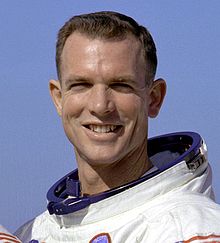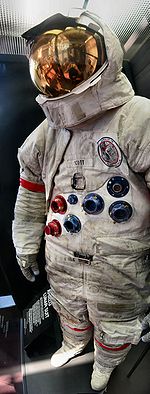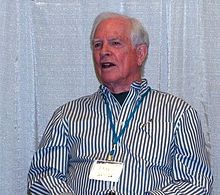- David Scott
-
For other people named David Scott, see David Scott (disambiguation).
David Scott 
NASA Astronaut Nationality American Status Retired Born June 6, 1932
San Antonio, Texas, U.S.Other occupation Test Pilot Rank Colonel, USAF Time in space 22d 18h 53m Selection 1963 NASA Group Missions Gemini 8, Apollo 9, Apollo 15 Mission insignia 


David Randolph Scott (born June 6, 1932) is an American engineer, test pilot, retired U.S. Air Force officer, and former NASA astronaut and engineer, who was one of the third group of astronauts selected by NASA in October 1963. As an astronaut, Scott became the seventh person to walk on the Moon.
Before becoming an astronaut, Scott graduated from the West Point Military Academy and joined the United States Air Force. Scott eventually retired from the Air Force in 1975 with the rank of Colonel, and more than 5600 hours of logged flying time.
As an astronaut, Scott made his first flight into space as pilot of the Gemini 8 mission along with Neil Armstrong in March 1966, spending just under eleven hours in Low Earth orbit. Scott then spent ten days in orbit as Command Module Pilot aboard Apollo 9, his second spaceflight, along with Commander James McDivitt and Lunar Module Pilot Rusty Schweickart. During this mission, Scott became the last American to fly solo in Earth orbit (not counting subsequent untethered EVAs). Scott made his third and final flight into space as commander of the Apollo 15 mission, the fourth human lunar landing, becoming the seventh person to walk on the Moon and the first person to drive on the Moon.
Contents
Early life and education
He was born on Randolph Field (for which he received his middle name) near San Antonio, Texas and was active in the Boy Scouts of America where he achieved its second highest rank, Life Scout.[1] He was educated at Texas Military Institute, Riverside Polytech High School in Riverside, California, where Scott joined the swim team and set several state and local swim records. Scott attended The Western High School in Washington, D.C. graduating in June 1949. In DC he was an honor student, on the school swim team and the Ambassador hotel AAU champion tean as a record setter. He attended the University of Michigan for one year where he was an honor student in the Engineering school, a member of the swimming team and pledged Sigma Chi Fraternity before finally receiving an invitation to attend West Point where he finished 5th in his class out of 633 in 1954. Because of his high standing in the class, he was able to choose which branch of the military he would serve. Scott choose the Air Force because he wanted to fly jets.[2] In 1959 he married his first wife, Ann.[3] He received both an S.M. degree in Aeronautics/Astronautics and the degree of Engineer in Aeronautics/Astronautics (the E.A.A. degree) from MIT in 1962.[4] He also received an honorary doctorate of Astronautical Science from the University of Michigan in 1971. He is of Scottish descent.
NASA career
Scott was the first of the Group Three astronauts to be selected to fly and was also the first to command a mission of his own.
Gemini 8
On March 16, 1966, he and command pilot Neil Armstrong were launched into space on the Gemini 8 mission, a flight originally scheduled to last three days, in which Scott was to perform an EVA, but terminated early due to a malfunctioning thruster. The crew performed the first successful docking of two vehicles in space and demonstrated great piloting skill in overcoming the thruster problem and bringing the spacecraft to a safe landing. Scott would later perform EVA's on his two subsequent flights.
Apollo 9
Scott served as command module pilot for Apollo 9 (March 3–March 13, 1969). This was the third manned flight in the Apollo series, the second to be launched by a Saturn V, and the first to complete a comprehensive earth-orbital qualification and verification test of a "fully configured Apollo spacecraft." The ten-day flight provided vital information previously not available on the operational performance, stability, and reliability of lunar module propulsion and life support systems. Highlight of this evaluation was completion of a critical lunar-orbit rendezvous simulation and subsequent docking, initiated by James McDivitt and Russell Schweickart from within the lunar module at a separation distance which exceeded 100 miles (160 km) from the command/service module piloted by Scott. The crew also demonstrated and confirmed the operational feasibility of crew transfer and extravehicular activity techniques and equipment, with Schweickart completing a 46-minute EVA outside the lunar module. During this period, Dave Scott completed a 1-hour stand-up EVA in the open command module hatch photographing Schweickart's activities and also retrieving thermal samples from the command module exterior. Apollo 9 splashed down less than four nautical miles (7 km) from the helicopter carrier USS Guadalcanal (LPH-7).
In his next assignment, Scott was designated backup spacecraft commander for Apollo 12.
Scott conducting an experiment during the Apollo 15 moon landing.
Apollo 15
Scott made his third space flight as spacecraft commander of Apollo 15 (July 26–August 7, 1971). His companions on the flight were Alfred M. Worden (command module pilot) and James B. Irwin (lunar module pilot). Apollo 15 was the fourth successful manned lunar landing mission and the first to land near mountains instead of the relatively flat mare region where the previous 3 missions had landed. The landing site was between 2 mountains just north of Hadley Rille and Apennine Mountains which are located on the southeast edge of the Mare Imbrium (Sea of Rains). After landing, Scott and Irwin donned their pressure suits and Scott performed the first and only stand up EVA on the lunar surface. He stood on the engine cover and poked his head out the docking port on top of the lunar module and took panoramic photographs of the surrounding terrain from an elevated position and scouted the terrain they would be driving across the next day. The lunar module, "Falcon," remained on the lunar surface for 66 hours and 54 minutes (setting a new record for lunar surface stay time) and Scott and Irwin logged 18 hours and 35 minutes each in extravehicular activities conducted during three separate excursions onto the lunar surface. Using "Rover-1" to transport themselves and their equipment along portions of Hadley Rille and the Apennine Mountains, Scott and Irwin performed a selenological inspection and survey of the area and collected 180 pounds (82 kg) of lunar surface materials. They deployed an ALSEP package which involved the emplacement and activation of surface experiments, and their lunar surface activities were televised using a TV camera which was operated remotely by ground controllers stationed in the mission control center located at Houston, Texas. Other Apollo 15 achievements include: largest payloads ever placed into earth and lunar orbits; first scientific instrument module bay flown and operated on an Apollo spacecraft; longest distance traversed on lunar surface; first use of a lunar surface navigation device (mounted on Rover-1); first subsatellite launched in lunar orbit; and first extravehicular (EVA) from a command module during transearth coast. The latter feat performed by Worden during three excursions to "Endeavour's" SIM-bay where he retrieved film cassettes from the panoramic and mapping cameras and reported his personal observations of the general condition of equipment housed there. Apollo 15 concluded with a Pacific Ocean splashdown and subsequent recovery by the USS Okinawa.
Awards and honors
Scott has been awarded two NASA Distinguished Service Medals, a NASA Exceptional Service Medal, two Air Force Distinguished Service Medals, the Distinguished Flying Cross, the Air Force Association's David C. Schilling Trophy and the Robert J. Collier Trophy.
In the 1998 television series From the Earth to the Moon Scott was portrayed by Brett Cullen.
Stamp incident
Main article: Apollo 15 postage stamp incident David Scott's Apollo 15 space suit on display in the Air and Space Museum, Washington, DC.[5]
David Scott's Apollo 15 space suit on display in the Air and Space Museum, Washington, DC.[5]
After the return of Apollo 15 to Earth, it was discovered that, without authority, Scott, with the knowledge of his crew, had taken 398 commemorative postal covers to the moon of which a hundred were then sold to a German stamp dealer. The profits of the sale would have been used to establish trust funds for the Apollo 15 crew's children. Although their action was not in any way illegal, and despite the fact that NASA had turned a blind eye to similar activities on earlier flights, the administration decided to make an example of Scott and his crew and none of them flew in space again.[citation needed]
According to his autobiography (Deke! [ISBN 978-0-312-85918-3]), Deke Slayton, Chief of the Astronaut Corps, felt Scott, Worden and Irwin had embarrassed NASA and the Apollo program by trying to profit in such way from the hard work that had gone into the Apollo 15 mission, not to mention it went completely against NASA rules. He confronted them and they told him what they'd done and why, and it was then that Slayton took them off the back-up crew of Apollo 17 and effectively ended their careers as astronauts. Worden went on to work at Ames Research Center and Scott was placed in the Manned Spacecraft Center. Irwin left NASA to become a full-time preacher.
Post-NASA career
- On April 18, 1975, at age 42, Scott became the Center Director of NASA's Flight Research Center, a position he held until October 30, 1977.
- He commentated for British TV on the first Space Shuttle flight (STS-1) in April 1981.
- He also consulted on the movies Apollo 13 for Ron Howard and was on the set for much of the filming of the HBO mini-series From the Earth to the Moon, where he advised both Tom Hanks and the various directors, as well as answered questions from the actors on set.
- In 2000 he was briefly engaged to British television newscaster Anna Ford.[6]
- In 2003-2004 he consulted on the BBC TV series Space Odyssey: Voyage To The Planets
- In 2004, he and former Soviet cosmonaut Alexei Leonov began work on a dual biography / history of the "Space Race" between the United States and the Soviet Union. The book, "Two Sides of the Moon: Our Story of the Cold War Space Race" was published in 2006. Neil Armstrong and Tom Hanks both wrote introductions to the book.
- He currently resides in Los Angeles, California with his wife, Margaret "Mag" Black-Scott, an executive for Morgan Stanley.[7]
- Scott is one of the astronauts featured in the book and documentary In the Shadow of the Moon, and was instrumental in helping to get the film off the ground.
Notes
- ^ "Astronauts and the BSA". Fact sheet. Boy Scouts of America. http://www.scouting.org/Media/FactSheets/02-558.aspx. Retrieved 2006-03-20.
- ^ Two Sides of the Moon, PP18-28
- ^ "Anna Ford's affair with ex-astronaut burns out". Daily Telegraph. http://www.telegraph.co.uk/news/uknews/1334746/Anna-Fords-affair-with-ex-astronaut-burns-out.html. Retrieved 2011-03-07.
- ^ "To the moon, by way of MIT". Web.mit.edu. 2009-06-03. http://web.mit.edu/newsoffice/2009/apollo-tt0603.html. Retrieved 2010-03-05.
- ^ "Pressure Suit, A7-LB, Scott, Apollo 15". Smithsonian National Air and Space Museum. http://www.nasm.si.edu/collections/artifact.cfm?id=A19740189000. Retrieved 2010-03-05.
- ^ Smith, Andrew (2005). Moondust: in search of the men who fell to Earth. New York: Fourth Estate. pp. 324–325. ISBN 9780007155415. OCLC 58720734.
- ^ Times, The (2006-09-09). "Memories that won't be forgotten". Jacksonville.com. http://www.jacksonville.com/tu-online/stories/090906/bum_4903546.shtml. Retrieved 2010-03-05.
References
- Scott, David; Alexei Leonov (2006). Two Sides of the Moon: Our Story of the Cold War Space Race. with Christine Toomey. St. Martin's Griffin. ISBN 0312308663.
- Some years after his career at NASA concluded, Scott wrote this book with Alexei Leonov, the first person to walk in space, about being on opposite sides of the space race during the Cold War.
- In the Shadow of the Moon, Francis French and Colin Burgess, UNP, 2007.
External links
- David R. Scott: Official NASA biography
- David R. Scott: Challenges facing the human exploration of Mars public lecture at the Royal Society in London
- David R. Scott: Spacefacts biography
People who have walked on the Moon Neil Armstrong (CDR, Apollo 11) · Buzz Aldrin (LMP, Apollo 11) · Pete Conrad (CDR, Apollo 12) · Alan Bean (LMP, Apollo 12) · Alan Shepard (CDR, Apollo 14) · Edgar Mitchell (LMP, Apollo 14) · David Scott (CDR, Apollo 15) · James Irwin (LMP, Apollo 15) · John Young (CDR, Apollo 16) · Charles Duke (LMP, Apollo 16) · Eugene Cernan (CDR, Apollo 17) · Harrison Schmitt (LMP, Apollo 17)
NASA Astronaut Group 3, "The Fourteen", 1963 Buzz Aldrin · William Anders · Charles Bassett · Alan Bean · Eugene Cernan · Roger Chaffee · Michael Collins · Walter Cunningham · Donn Eisele · Theodore Freeman · Richard Gordon · Russell Schweickart · David Scott · Clifton Williams
NASA Astronaut Groups · NASA Astronaut Corps Categories:- 1932 births
- Living people
- People from San Antonio, Texas
- 1966 in spaceflight
- 1969 in spaceflight
- American astronauts
- Apollo 15
- Massachusetts Institute of Technology alumni
- People who have walked on the Moon
- United States Military Academy alumni
- United States Air Force officers
- United States Astronaut Hall of Fame inductees
- American people of Scottish descent
- USAF Test Pilot School alumni
- Fellows of the Chartered Institute of Linguists
Wikimedia Foundation. 2010.

